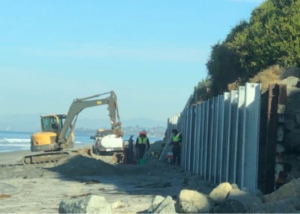Environmental surveys take place along the Eglinton Crosstown West Extension route
Written by David C. Lester, Editor-in-Chief
Environmental assessments have become standard events for just about all rail projects, including new lines, line expansion, and some types of repair.
Metrolinx senior advisor to the subway program, Kimberly Murphy, tells us about the details of how the environment and its inhabitants are kept safe during construction work.
Turtles, bats, and birds are being studied along the Eglinton Crosstown West Extension route, as experts make sure work doesn’t disrupt important habitats of even the smallest creatures. Over the spring and summer, teams from Metrolinx have been examining local wildlife along the route as part of the planning process for the project. Read on to learn more about how all living things – big or small, winged or shelled – get factored into new transit plans.
Critters are being given their due along the Eglinton Crosstown West Extension (ECWE) rapid transit line.
When Metrolinx News writes about transit planning, the stories often centre around people – how a new transit connection will benefit a local community when it’s in operation, or how impacts will be managed while it’s being built. But good transit plans also give a detailed view of the local environment, including the wildlife along the route and how Metrolinx will be a good neighbour to members of the animal kingdom, too.
The team working on the Eglinton Crosstown West Extension, a project that will extend the Eglinton Crosstown LRT another 9.2 kilometres west from Mount Dennis station to Renforth Avenue in Mississauga, is currently looking at some special turtles, birds, and bats that might call this part of the city home.
These creatures are special because they’re identified as species at risk. The first step is to identify whether they are in the area of the transit line or close to where construction will take place.
“If the researchers discover the presence of an at-risk species, the next step is for Metrolinx to figure out how to make sure they protect them,” says Carrie Sheaffer, senior manager of environmental programs and assessment team at Metrolinx.
“This could mean creating buffer zones around nesting species or even changing construction schedules to keep areas clear at critical times. Understanding which species are in the area is a critical part of transit planning.”
Turtle basking surveys
To determine if turtles are living along the route of the line, teams of qualified biologists conducted turtle basking surveys.
Turtles alternate between swimming and basking – which is like sunbathing – throughout the day. They “bask” regularly to regulate their body temperature, often on top of rocks, floating logs, or other surfaces where they can dry off and soak up the warmth of the sun.
The biologists were on the lookout for one species in particular – the Blanding’s Turtle, which is an endangered species.

In May and June, biologists combed the areas along the route to look for any evidence of turtles. These surveys needed to be done during the right conditions to get a glimpse of the turtles soaking up the sun – they had to be done on sunny days, during daytime hours, and when the temperature was above 5C, but below 25C.
Teams did not observe any at-risk turtle species during their surveys.
Breeding bird surveys
To see if certain at-risk bird species live in areas around the project, including Bank Swallows, Barn Swallows, and Chimney Swifts, biologists looked and listened for evidence of certain breeding behaviour.There are a number of ways to look for this, including listening for singing male birds, finding evidence of birds building nests and caring for eggs, and spotting birds carrying food, and feeding young birds. These surveys needed to be done in a particular season, when birds are breeding in the spring.

Teams observed Barn Swallows and Chimney Swifts flying in the area and are now determining whether they are living near the project and what would need to be done to protect their nests if they are.
Bat acoustic surveys
Bats are an important part of an ecosystem, especially because they help control insects.
To survey local bat populations in wooded areas along the ECWE route, researchers installed detectors with ultrasonic microphones that record the high-pitched calls bats make as they fly and hunt for bugs.
The researchers were looking for four at-risk species of bats in particular: Little Brown Myotis, Northern Myotis, Small-footed Myotis, and Tri-colour Bat. They conducted surveys over 30 nights during the peak of the bat maternity season in June, on nights when the air is warm and when there is no rain.
Researchers found Little Brown Myotis and Small-footed Myotis bats in a number of the wooded areas across the study area.

Metrolinx is now analyzing the data to figure out if there are any potential impacts to the bat’s habitat and what might be needed to protect them.
One of the ways to protect bats would be to install ‘bat boxes.’ They are small wooden houses that bats can use to roost in the spring, summer, and early fall. These boxes provide shelter for the bats to stay warm, dry, and safe from predators.
The biologists will work to find the right locations for the boxes, so they are close to good feeding areas and have the right amount of sunlight and shade to keep their temperatures comfortable.
Understanding the local environment is a key step in transit planning for the ECWE – even if the local turtles, birds, and bats might not get the chance to take a ride.
For the latest information on the Eglinton Crosstown West Extension, visit the project website and follow the project on Twitter @EglintonWestEXT.





